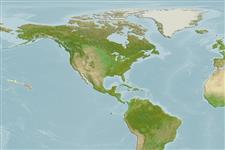Teleostei (teleosts) >
Eupercaria/misc (Various families in series Eupercaria) >
Labridae (Wrasses) > Xyrichtyinae
Etymology: Ammolabrus: Greek, ammos = sand + see Labrus; dicrus: From the Greek dikros, forked, in reference to the forked caudal fin..
More on authors: Randall & Carlson.
Environment: milieu / climate zone / depth range / distribution range
Ecology
Marine; benthopelagic; depth range 7 - 18 m (Ref. 26794). Tropical
Distribution
Countries | FAO areas | Ecosystems | Occurrences | Point map | Introductions | Faunafri
Eastern Central Pacific: known only from O'ahu, Hawaiian Islands.
Size / Weight / Age
Maturity: Lm ? range ? - ? cm
Max length : 9.4 cm SL male/unsexed; (Ref. 26794)
Dorsal spines (total): 9; Dorsal soft rays (total): 12; Anal spines: 3; Anal soft rays: 12; Vertebrae: 25. Flexible anal fin spines; 19 or 20 + 5 or 6 pored lateral line scales with single horizontal tubule, ending in a pore; scales thin and rhomboidal, those of thorax and anterior abdomen smaller than those of side of body; head naked except for 2 small scales dorsally on opercle and diagonal row of 5 partially embedded scales behind eye; no median predorsal scales; 3 small median prepelvic scales; anterior third of prepelvic region naked; branchiostegal rays 6; upper jaw strongly protrusible, median process of premaxilla extending to above anterior pupil edge; body moderately elongate, the depth 4.2-4.45 in SL; dorsal part of head from front of snout to origin of dorsal fin with a fleshy median ridge, the interorbital space high and triangular when viewed from the front; interorbital space narrowest anteriorly; caudal fin small, 1.45-1.65 in head length; pelvic fins small, 2.2-3.05 in head length (Ref. 26794).
Adults are found over open sand bottom, in small, swift-swimming schools (Ref. 26794). Feed on zooplankton above the substratum (Ref. 26794, 58466). Oviparous, distinct pairing during breeding (Ref. 205).
Life cycle and mating behavior
Maturities | Reproduction | Spawnings | Egg(s) | Fecundities | Larvae
Oviparous, distinct pairing during breeding (Ref. 205).
Parenti, P. and J.E. Randall, 2000. An annotated checklist of the species of the labroid fish families Labridae and Scaridae. Ichthyol. Bull. J.L.B. Smith Inst. Ichthyol. (68):1-97. (Ref. 35918)
IUCN Red List Status (Ref. 130435)
Threat to humans
Harmless
Human uses
Tools
Special reports
Download XML
Internet sources
Estimates based on models
Phylogenetic diversity index (Ref.
82804): PD
50 = 1.0000 [Uniqueness, from 0.5 = low to 2.0 = high].
Bayesian length-weight: a=0.00676 (0.00275 - 0.01660), b=3.05 (2.84 - 3.26), in cm total length, based on LWR estimates for this (Sub)family-body shape (Ref.
93245).
Trophic level (Ref.
69278): 3.3 ±0.4 se; based on size and trophs of closest relatives
Resilience (Ref.
120179): High, minimum population doubling time less than 15 months (Preliminary K or Fecundity.).
Fishing Vulnerability (Ref.
59153): Low vulnerability (10 of 100).
